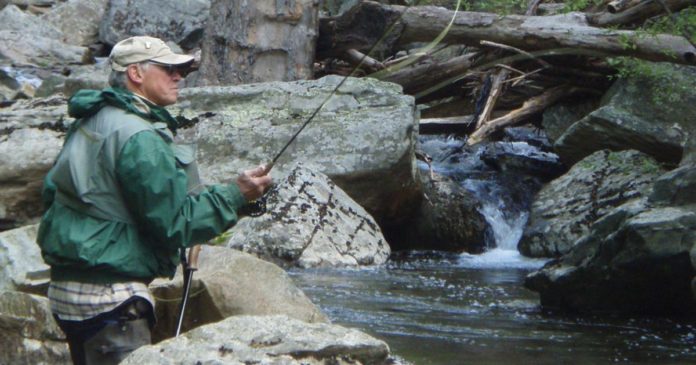Jim Kennedy has a grand vision for the prospective flyfishing heritage trail that is being proposed to follow Big Hunting Creek beginning in the town of Thurmont upstream into Catoctin Mountain National Park and Cunningham Falls State Park. Kennedy is an enthusiastic advocate of a trail that will commemorate the robust history of the famous figures who have fished the waters of Big Hunting Creek and the founding members of the Brotherhood of the Jungle Cock.
Kennedy is not only a passionate fly angler and conservationist, he is also a trustee of the Brotherhood of the Jungle Cock — an organization dedicated to helping young people understand and appreciate the sport of angling and the resources upon which it depends. Kennedy believes that a fly-fishing trail that begins near the BOJC statue near the shoreline of Big Hunting Creek as it exits Thurmont Community Park and extends upstream to the Joe Brooks Memorial in Catoctin Mountain Park would be fitting.
Big Hunting Creek is the birthplace of the Brotherhood of the Jungle Cock founded in 1939 with offspring chapters in Michigan, New York, Ohio, Pennsylvania and Virginia. Big Hunting Creek was the first stream in the state of Maryland to be designated as fly-fishing only. Later it became Maryland’s first catch-and-release trout stream.
History of Big Hunting Creek
Big Hunting Creek is a small, freestone, mountain stream that flows from its headwaters above Cunningham Falls into Cunningham Falls Lake and progresses downstream through Cunningham Falls State Park on the south side of Route 77 before crossing into Catoctin Mountain Park. Continuing downstream, Big Hunting Creek flows through the town of Thurmont before meeting the Monocacy River below Creagerstown, Maryland.
Big Hunting Creek has played a prominent role in the development of recreational trout fishing in Maryland. The National Park Service website describes Big Hunting Creek as one of the most significant freshwater fisheries in Maryland. The stream has long been popular among fly-fishers. Big Hunting Creek supports one of the strongest populations of wild brown trout in the state. Brown trout are found throughout the watershed from the tiny headwaters downstream through the town of Thurmont.
Big Hunting Creek is located in close proximity to Camp David and has been fished by a number of U.S. presidents, including Franklin D. Roosevelt, Dwight Eisenhower, Herbert Hoover, and Jimmy Carter. Big Hunting Creek is truly a historic trout stream and is very popular with fishing enthusiasts and park visitors who enjoy viewing trout in a natural mountain setting.
Youth fly fishing zone proposal
A youth fly-fishing zone is being proposed by the Maryland Chapter of the Brotherhood of the Jungle Cock on the land where Frank Bentz Memorial Lake now stands. The Maryland Department of Natural Resources is planning to build a small park in that area once the dam on the pond is removed.The dam and spillway have been deemed unsafe and are set for demolition that could begin as early as this summer, depending on state funding.
The Maryland BOJC is advocating turning that newly formed section of Big Hunting Creek into a youth-only fly-fishing catch and return fishery in honor of Frank Bentz Sr. and the conservation ethic he promoted throughout his life. Bentz was one of the Brotherhood’s three founders dating to 1939.
Catoctin Mountain trail system plan
The National Park Service is developing a comprehensive Trail System Plan/Environmental Assessment for Catoctin Mountain Park in Thurmont. Catoctin Mountain Park currently has 25 miles of developed trails that provide several scenic viewpoints, universally accessible trails and 6 miles of horseback riding trails. The purpose of the proposed project is to provide comprehensive guidance for enhancing the park’s trail system and visitor experience in a manner that highlights and protects the natural and cultural resources.
A comprehensive trail system plan would provide park managers with a long-term management framework to manage and maintain existing trails, add new trails and access points, provide more connected and looped trail experiences, close or realign existing trails, and create trails that are accessible to visitors with disabilities.
In addition, the system planners will consider allowing use of bicycles on an administrative road, improve vehicle and pedestrian circulation within the park, create connections to local, regional and national trail systems, including the Appalachian Trail, improve and add parking areas, and designate a fly fishing heritage trail.
You’re invited to review an environmental assessment (EA) for the project and submit comments from Jan. 5 through Feb. 3, 2022. To provide comments online or find additional information on the project, visit the NPS planning website at: parkplanning.nps.gov/cato_trailplan.
Credit: Source link































